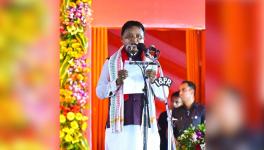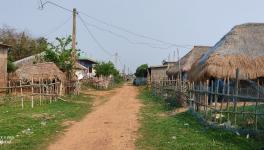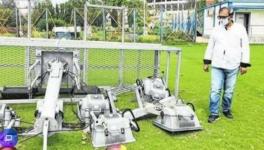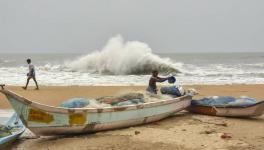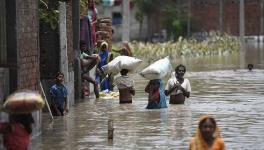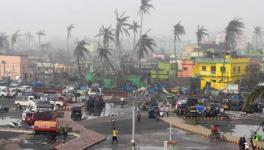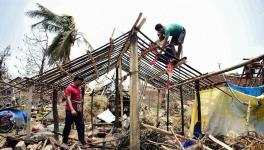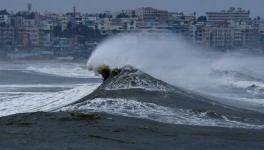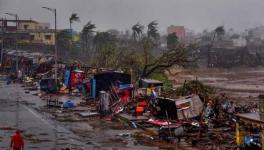Odisha: 1 Month After Cyclone Fani, Dalit Communities Still Struggling to Get Back to Normal Life
Image for representational use only.Image Courtesy : The Hindu
A month after the devastating cyclone Fani, the people of Odisha, especially the dalit communities are not yet back to their normal lives. As per reports from the affected areas, caste plays a major role in shaping the future of cyclone victims.
In Kantpada village in Puri, one among the worst affected places, dalits are not even allowed to enter is the government built shelters. Even within dalits, there are many sub-castes which have different levels of hierarchy.
“After the cyclone, we have visited the area and a shelter home at Balabhadrapur. People from Bhoi and Dom communities (dalits) were not allowed to enter this shelter. Since the fisherfolk community was staying at the Odisha Tourism Development Corporation (OTDC) building, the Bhoi and Doms had to go to the nearest school which is 1 km away from their hamlet. Within the school too, there is hierarchy among the Bhoi and Dom,” said Sandeep Pattnaik of National Centre for Advocacy Studies who is working in this region.
He said, “In the school, all are using the same toilet and people are unhappy with it. When the food comes, it goes to the upper castes first.”
Read More: Cyclone Fani-hit People Unhappy with Rehabilitation Work, Stage Protests
The incidences of caste discrimination at the shelter homes in Kantpada village is not an isolated one. In Odisha, certain villages still practice the age-old brahmanical practices of discrimination. Women and dalits don’t even have a space in the streets of these villages, Pattnaik observed.
The extremely severe cyclonic storm had made landfall on May 3 near Puri and had affected 14 districts of the state. Nearly 1.65 crore people were affected while 64 people lost their lives in the disaster. Puri, Bhubaneswar, Khurda and Jagatsinghpur are the most affected districts.
In Puri, Krushnaprasad and Brahmagiri are the worst affected blocks, where dalits and fisherfolk constitute the majority population. Dalits stay in small hamlets which are not at equipped to sustain during natural calamities.
After the 1999 super cyclone experience, several policies had been taken to cope with such natural disasters, which, of course, helped in the evacuation of over 11 lakh people this time. After the 1999 experience, around 800 multi-purpose cyclone and flood shelters were built in the state.
Pattnaik said, “The cyclone shelters were built in the revenue villages where the upper caste people generally live and they don’t allow the dalits. Even if the dalit leaders ask for their rights that they want to stay in the cyclone shelter, they are not being allowed. It is a systemic problem.”
Read More: Massive Evacuation in Odisha as Cyclone 'Fani' Rolls Menacingly
Amid these conditions, the main demands from the ground are that the cyclone shelters should be built in the dalit hamlets, so that they can access it in times of need. Also, dalits must be included in all the local management committee for the cyclone shelters. Now, such committees are managed by upper castes, while dalits and women are not part of it.
“Dalits and women should be the priority,” said Pattnaik adding, “the state government gives funds to shelters, but we have learned from the people that no such maintenance works are happening in the ground. So there should be accountability and transparency for these things.”
Though the state government’s rescue efforts are commendable, the rehabilitation activities are not reaching all the people. One of the main problems is that dalits don’t own land and are staying in lands which belong to the temple and different Mathas (monasteries). Dalits have traditionally been working as caretakers here. “We demand the allocation of land and pakka houses for these people,” Pattnaik said.
“Now the situation will get really worse because the monsoon is coming in 10-15 days. Most of these dalit hamlets have not had their roofs repaired yet and the government has not done anything. If the government is not intervening in this matter, there will be a huge migration from this area to other areas,” he added.
Even though the causalities were less, there was a huge impact on the lives of people and their properties. The government claims that the damage assessment by the departments and the collectors is almost over and the memorandum to the Government of India will be submitted soon. A preliminary report of damage amounts to Rs 11,942.68 crore.
Since the fisherfolk community has lost their boats and nets, they are not able to go out into the Bay of Bengal, bringing their livelihood to a standstill. “So we urge the government to offer jobs through MGNREGA,” Pattnaik said.
He added, “Also, for the next three months, the payments should be offline since there is no electricity and internet.”
According to the government officials, about 48% of the electricity connections in Puri district are yet to be restored. “Only 1,51,889 out of 2,91,171 affected consumers (52%) have got electricity in Puri district within a month," said an official on Monday.
Out of 25,01,131 affected consumers in the districts of Angul, Dhenkanal, Cuttack, Puri, Nayagarh, Khurdha, Kendrapada, Jagatsinghpur and Jajpur, electricity has been restored to 23,36,584 consumers till May 31, the official added.
While 99% of the consumers have got electricity in Cuttack district, power has been restored for 96% of the consumers in Khurda. All consumers in Kendrapara and Kagatsinghpur have got power supply.
Read More: A Month After Fani, 1.64 Lakh Families Still Without Electricity in Odisha
Get the latest reports & analysis with people's perspective on Protests, movements & deep analytical videos, discussions of the current affairs in your Telegram app. Subscribe to NewsClick's Telegram channel & get Real-Time updates on stories, as they get published on our website.









